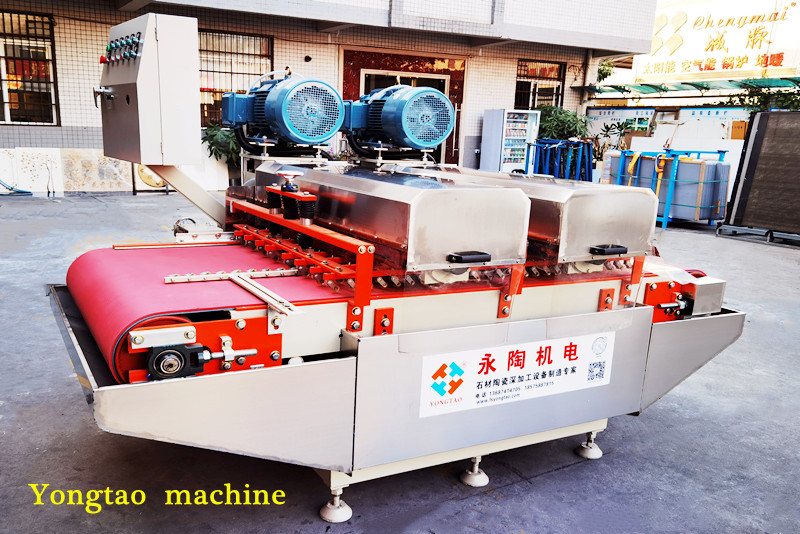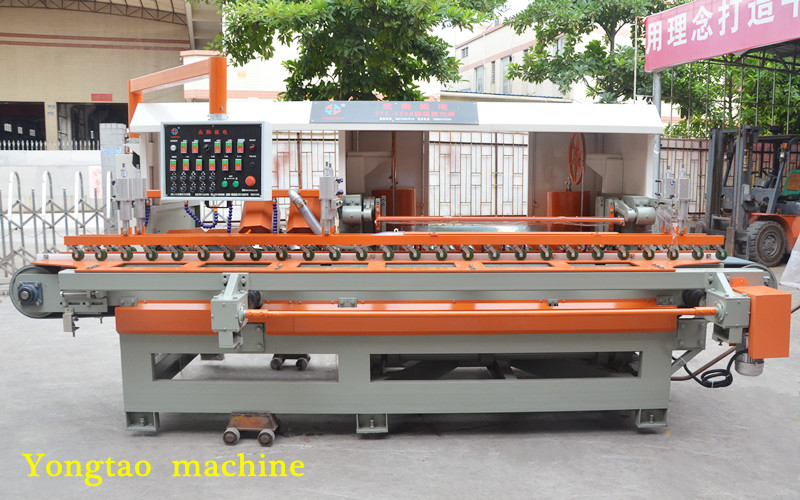Being paved in order can make the texture of ceramic tile stretch better, but the effect of ceramic tile is more than it. With the development of marble tiles being bigger and more transparent, the advantages of the transparent marble are better displayed in the further processing, and various three-dimensional and aesthetic decorative effects are presented through the further processing of chamfering, grooving, rounding edge, etc. In addition, the ceramic tile can also use the second processing methods such as water-jet medallion, paving of certain combination model and embossing to improve the spatial vividness to a greater extent. The ceramic tile processing machinery we sell can meet your various needs for ceramic tile processing.
Ceramic cutting machine:

1. Slotting
Slotting, which means cutting grooves on the surface of ceramic tile. In the past, it was widely used in stone materials, but with the introduction of transparent marble tiles and ceramic tiles, ceramic tiles can also make the effect of slotting. Slotting can be adopted on the the ladder, which can have the effect of anti-skid and beauty. The common ones are two, three and four anti-skid grooves.
In addition to the ladder application, the floor tile paved on the wall can also be slotted, such as applied in toilet, living room and other places.
2. Chamfering
Chamfering is mainly used on the treatment of the wall corner, which is a more traditional way of external corner treatment.
Two tiles are ground into 45 degree angle, and then pasted diagonally, which seems to be a very simple laying skill. In fact, it is a test of the decorator's skill, and the properly processed chamfer is more beautiful and superior than the direct use of external angle line.
It is worth mentioning that the 45 degree chamfer is not actually 45 degrees, but about 30 degrees. Only in this way can there be a gap between the corners of the two tiles (if it is really cut into 45 degrees, the two tiles are put together to form a right angle, and there is no gap), and then binder can be used to fill the gap.
Attention shall be paid not to grind the tiles too thin during construction, so as to avoid cracks at the joints in the later stage.
3. Rounding edge
Rounding edge, as the name implies, is to grind the edges and corners of ceramic tiles to avoid being too sharp. It can be applied to the round edge of ceramic tile, windowsill stone and countertop of hearth.
At present, it is commonly used in the treatment of mesa, windowsill paving or edge rounding of step.
Ceramic Bullnose Machine:

4. L groove
L groove is mainly used in the dry hanging of ceramic tiles, such as large-scale ceramic tiles paved on the wall needs dry hanging through L groove generally , so that the ceramic tiles have support to achieve being paved on the wall.
Floor tiles paved on the wall are welcomed by more and more owners because of its nobleness and beauty.
5. Modeling
The modeling can be called combination tiling. For example, diamond, circulative type, triangle, wavy line and other paving methods are to be completed through secondary cutting, and the changeable shape makes the dimensional effect richer.
6. Water-jet medallion
The cost of water-jet medallion is not cheap. But its magnificence is incomparable. Without the combination of water-jet medallion, it can not be called a luxury house. Its cost depends not only on the square of the house, but also on the complexity of the pattern.
Although there is now a direct ink-jet "water-jet medallion", it looks true if you do not observe carefully, but it is worse in quality compared with the real water jet flower.
7. Relief
Ceramic tiles use sandblasting to achieve relief effect. Oil paper is cut into patterns by equipment, and oil paper is pasted on the ceramic tiles. The cut patterns can be removed and sand blasting can be carried out. Concave and convex relief effect, makes the pattern on the ceramic tile present vividly, and it is generally applied to the background wall. Microcrystalline stone, marble tiles, full glaze can make good relief effect.
If you have the need to process ceramic tiles, you can learn about our ceramic tile processing equipment. If you have any questions or want to know more product information, please contact us!

 [email protected]
[email protected]
 Road 3, Wuzhuang Xiaofengtian Ind. Zone, Luocun Town, Nanhai Dist., Foshan, Guangdong, China
Road 3, Wuzhuang Xiaofengtian Ind. Zone, Luocun Town, Nanhai Dist., Foshan, Guangdong, China